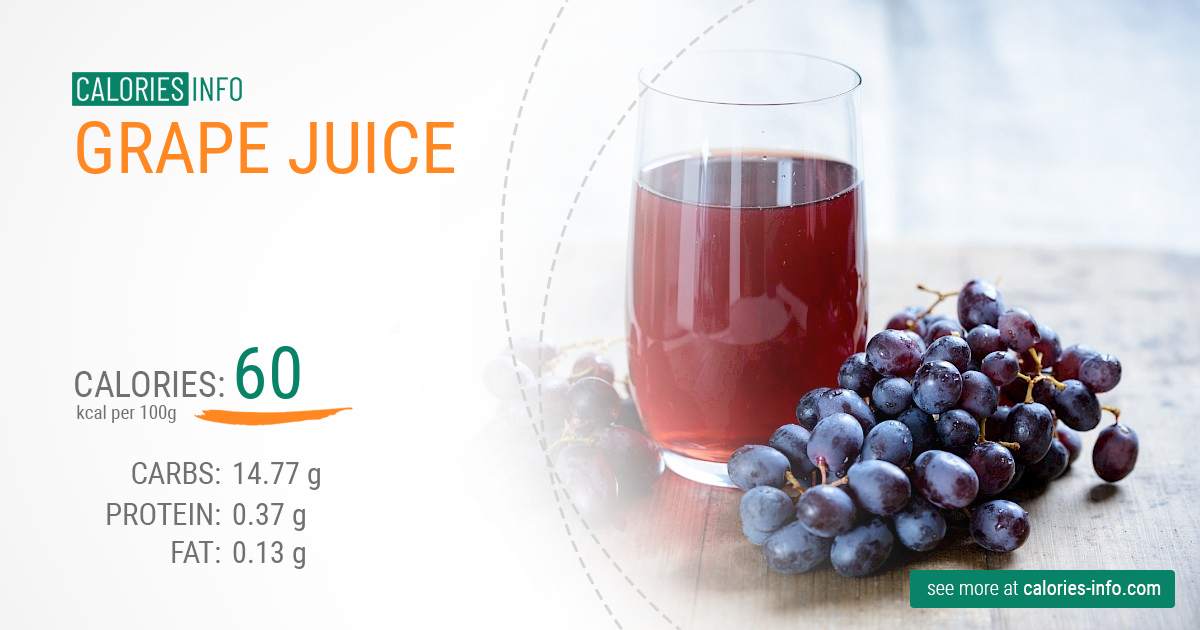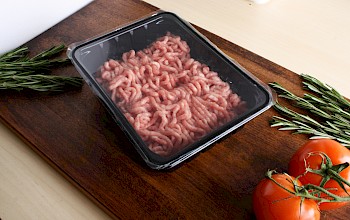Grape Juice: Calories and Nutrition Analyse
How many calories in grape juice?

Nutrition Facts
Grape JuiceServing size:
glass full of grape juice (215 g) change
5g10g15g20g30g40g50g60g80g100g120g140g160g180g200g220g250g300g350g400g450g500g600g700g800g900g1000g
1oz2oz3oz4oz5oz6oz7oz8oz10oz12oz15oz20oz25oz30oz35oz40oz50oz
Amount Per Serving:
100g of grape juice contain about 60 calories (kcal).
Calories per:
ounce
| glass
In particular, a glass full of grape juice (215 g) contain about 129 calories.
This is about 6% of the daily caloric intake for an average adult with medium weight and activity level (assuming a 2000 kcal daily intake).
Scroll down for details and nutrition tables.
To visualize how much 129 kcal actually is, keep in mind that the calorie content of glass of grape juice is similar to that of, for example:
- 2 apples
- 1.5 glasses of Coca Cola (220 ml glass)
- 1 slice of cheese
- 1 slice of bread
- 1 glass of milk
- 6.5 cubes of sugar
Take a quick look at the tables below for detailed information about grape juice nutrition.
100g of Grape Juice
Nutrition
- Calories60
- Carbs Total14.77 g
- Dietary fiber0.2 g
- Fat0.13 g
- Protein0.37 g
- Water84.51 g
Vitamins
- Vit A8 IU
- Vit B1 (Thiamine)0.017 mg
- Vit B2 (riboflavin)0.015 mg
- Vit B3 (Niacin)0.133 mg
- Vit B60.032 mg
- Vit C25 mg
Minerals
- Potassium104 mg
- Phosphorus0.4 mg
- Magnessium10 mg
- Calcium11 mg
- Sodium5 mg
- Iron0.25 mg
- Zink0.4 mg
Discover the Nutritional Wonders of Grape Juice
Grape juice, a popular beverage enjoyed by many across the globe, is not only refreshing but also packed with a variety of nutritional benefits. Whether you're looking to understand the calorie content or the vitamins and minerals it contains, this article will provide you with a comprehensive overview of grape juice nutrition, including details on protein, fat, and carbs in grape juice.
**Grape Juice Calories and Nutritional Content**
One of the first things people often want to know about any food or drink is its calorie content. A standard serving of grape juice (approximately 100 grams) contains about 60 calories. This makes it a relatively low-calorie option for those who are mindful of their intake. However, it's important to consider the sugar content, which stands at 14.2 grams per serving, contributing to the majority of its calorie content.
**Carbs in Grape Juice**
Carbohydrates are the primary macronutrient found in grape juice, with a serving containing 14.77 grams. Of this, only a small fraction is dietary fiber (0.2 grams), while the rest is mainly sugars. This high sugar content is something to be mindful of, especially for those watching their sugar intake or managing diabetes.
**Protein and Fat in Grape Juice**
When it comes to protein and fat, grape juice contains minimal amounts. Each serving has about 0.37 grams of protein and 0.13 grams of fat. Given these low levels, grape juice should not be relied upon as a significant source of either nutrient in a balanced diet. Instead, it can complement other protein and fat sources.
**Vitamins and Minerals in Grape Juice**
Grape juice is not just about calories and macronutrients; it also offers a variety of vitamins and minerals. It is a good source of Vitamin C, providing about 25 mg per serving, which is essential for immune function, skin health, and iron absorption. Other notable nutrients include calcium (11 mg), iron (0.25 mg), magnesium (10 mg), and potassium (104 mg), all of which play vital roles in maintaining bodily functions.
**The Role of Grape Juice in a Healthy Diet**
While grape juice can be a nutritious addition to your diet, it's important to consume it in moderation due to its high sugar content. Opting for 100% pure grape juice without added sugars can help maximize its health benefits. Additionally, incorporating it as part of a balanced diet, rich in a variety of fruits, vegetables, whole grains, lean proteins, and healthy fats, can contribute to overall health and well-being.
In conclusion, grape juice offers more than just a refreshing taste; it provides a range of nutritional benefits, from vitamins and minerals to a low-fat and low-protein content. By understanding the nutritional profile of grape juice, including its calorie, carb, protein, and fat content, you can make informed choices about including it in your diet in a way that supports your health goals.
How many calories are there in 1, 2, 3, or 5 servings of grape juice?
- Glass full of grape juice (215g)129 kcal
- Ounce (oz) of grape juice17 kcal
- Half of medium size servings of grape juice64.5 kcal
- Small size serving of grape juice (172g)103.2 kcal
- Big size grape juice (280g)167.7 kcal
- Two medium size servings of grape juice258 kcal
- Three medium size servings of grape juice387 kcal
- Four medium size servings of grape juice516 kcal
- Five medium size servings of grape juice645 kcal
Compare grape juice:
grape juice vs apple juice, grape juice vs cherry juice, grape juice vs pineapple juice, grape juice vs orange juice, see all compares of grape juice.

Similar calories number have:
See also:
Read this:
- How many calories do pork rinds have?
- Calories in a half of rainbow roll sushi
- Calories in whole rainbow roll sushi
- Calories for one, two or more rainbow sushi rolls
- How many carbs (carbohydrates) in Kung Pao chicken?
- How much fat in philadelphia sushi roll?
- How much protein in Milk shake?
- What is weight of red delicious apple?
- Pinot Noir calories per ounce (oz)
- Taco Bell Nachos calories per serving size



Add comment